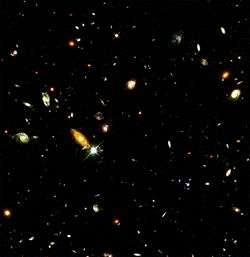Extragalactic astronomy
Extragalactic astronomy is the branch of astronomy concerned with objects outside the Milky Way galaxy. In other words, it is the study of all astronomical objects which are not covered by galactic astronomy.

The closest objects in extragalactic astronomy include the galaxies of the Local Group, which are close enough to allow very detailed analyses of their contents (e.g. supernova remnants, stellar associations). As instrumentation has improved, distant objects can now be examined in more detail and so extragalactic astronomy includes objects at nearly the edge of the observable universe.[1] Research into distant galaxies (outside of our local group) is incredibly valuable for studying aspects of the universe such as galaxy evolution[2] and Active Galactic Nuclei (AGN) which give insight into physical phenomena (e.g. super massive black hole accretion and the presence of dark matter[3]). It is through extragalactic astronomy that astronomers and physicists are able to study the effects of General Relativity[4] such as gravitational lensing[5][6] and gravitational waves, that are otherwise impossible (or nearly impossible) to study on a galactic scale.
Famous Examples of Extragalactic Astronomy
- Hubble Deep Field
- LIGO's detection of gravitational waves
- Chandra Deep Field South
Some Topics Include:
- Galaxy clusters, Superclusters
- Active Galactic Nuclei (AGN), Quasars
- Radio galaxies
- Supernovae
- Intergalactic stars
- Intergalactic dust[7]
- the observable universe
- Dark Matter
See also
References
- "Extragalactic Astronomy". as.arizona.edu. Retrieved 2020-04-18.
- "Astrophysics and General Relativity | Physics and Astronomy". physics.missouri.edu. Retrieved 2020-04-18.
- "Extragalactic Astronomy". Center for Astrophysical Sciences. Retrieved 2020-04-18.
- Collett, Thomas E.; Oldham, Lindsay J.; Smith, Russell J.; Auger, Matthew W.; Westfall, Kyle B.; Bacon, David; Nichol, Robert C.; Masters, Karen L.; Koyama, Kazuya; van den Bosch, Remco (2018-06-22). "A precise extragalactic test of General Relativity". Science. 360 (6395): 1342–1346. arXiv:1806.08300. Bibcode:2018Sci...360.1342C. doi:10.1126/science.aao2469. ISSN 0036-8075. PMID 29930135.
- "Gravitational Lensing". HubbleSite.org. Retrieved 2020-04-18.
- "Einstein's Relativity". www.astronomynotes.com. Retrieved 2020-04-18.
- M. E. Bailey; D. A. Williams (1988), Dust in the universe: the proceedings of a conference at the Department of Astronomy, University of Manchester, 14-18 December 1987, CUP Archive, p. 509, ISBN 978-0-521-35580-3